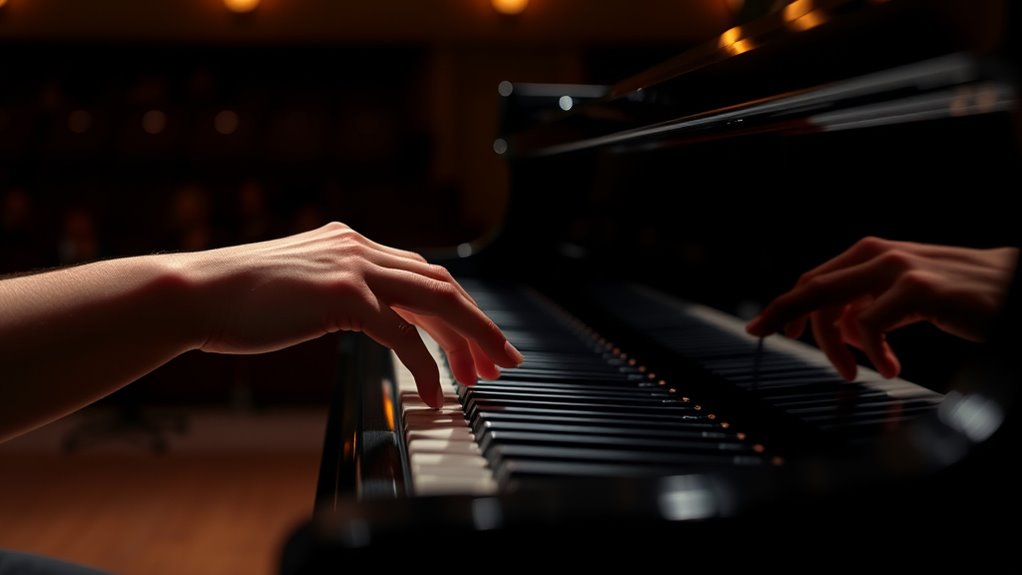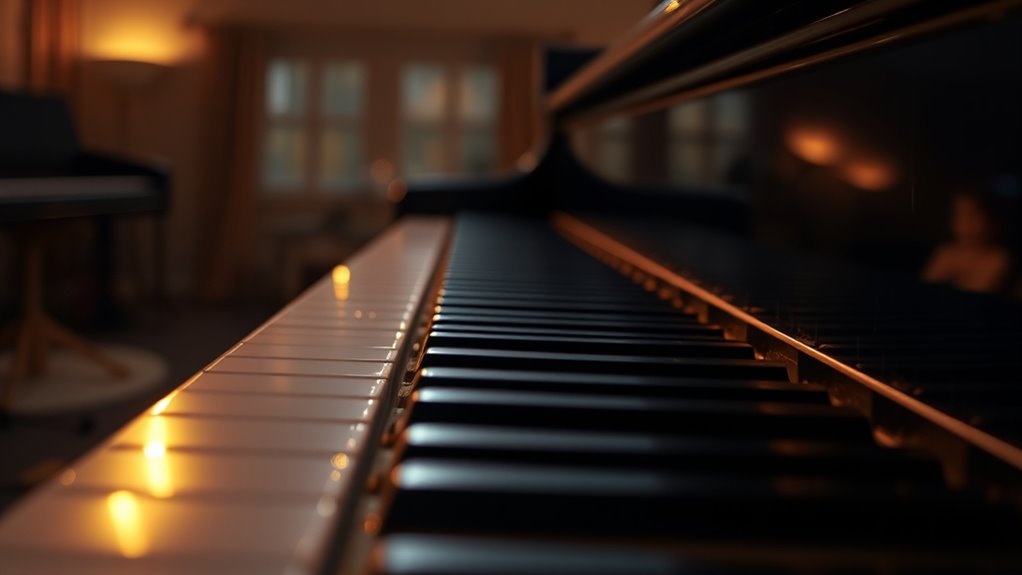To make your progressions sound cinematic, start by spreading out your voices across different octaves to add depth and clarity. experiment with suspended and added tone voicings to create tension and emotional releases. Incorporate unusual inversions with chromatic shifts for drama and unpredictability. Use smooth voice leading to enhance movement and natural flow. layer chords with dynamic rhythms and syncopation to build tension and excitement. Keep exploring these techniques to reveal more rich, cinematic sounds.
Key Takeaways
- Distribute chord tones across multiple octaves to add harmonic depth and a cinematic feel.
- Use suspended, added tones, and extended chords to create tension and emotional release.
- Incorporate unusual or chromatic inversions for dissonance and dramatic impact.
- Apply smooth, stepwise voice leading to enhance movement and emotional flow.
- Layer chords with dynamic rhythms and syncopation to increase complexity and cinematic atmosphere.
Spread Out the Voices for a Larger Sound

To create a bigger, more resonant sound, try spreading out the voices within your chords. This technique enhances layered textures, giving your progressions greater harmonic depth. Instead of stacking notes tightly, distribute the chord tones across different octaves, which creates space and richness. For example, voicing a chord with the root in the bass and spreading the other notes upward allows each note to stand out clearly. This approach not only makes your chords sound fuller but also adds a cinematic quality to your music by emphasizing the harmonic layers. By carefully spreading your voices, you craft a more immersive listening experience, making your progressions feel larger and more impactful without changing the fundamental harmony. Additionally, voice distribution helps prevent muddiness, ensuring each note remains distinct within the texture.
Use Suspended and Added Tone Voicings

Suspended and added tone voicings open up your chords, creating a sense of tension and release that keeps your progressions engaging. Suspended voicings replace the third with either a second or fourth, giving your harmony a floating quality. This creates anticipation, especially when resolving back to a standard chord. Added tone techniques involve including extra notes—such as ninths, elevenths, or thirteenths—that enrich the sound without overwhelming it. These voicings add color and complexity, making your progressions sound more cinematic. Use suspended and added tone voicings strategically, especially in transitions or climactic moments, to enhance emotional impact. Incorporating these techniques helps your chords breathe and evolve, making your progressions feel more dynamic and expressive. Understanding voicing techniques can further deepen the emotional resonance of your compositions.
Incorporate Unusual Inversions for Drama

Incorporating unusual inversions into your chord voicings can dramatically increase the emotional impact of your progressions. By using dissonant intervals within these inversions, you create tension that begs for resolution, adding drama and depth. Chromatic inversions—where notes are shifted by semitones outside the standard diatonic patterns—offer fresh, unexpected sounds that evoke cinematic qualities. For example, flipping a chord so that a dissonant interval like a minor second or augmented fourth becomes prominent can generate a haunting or tense atmosphere. These unconventional voicings challenge traditional chord structures, making your progressions more expressive. Experiment with chromatic inversions on key chords to evoke heightened emotion, tension, or mystery, transforming simple progressions into cinematic soundscapes. Additionally, understanding chord voicing techniques can help you craft more innovative and emotionally charged progressions.
Play With Voice Leading to Enhance Movement

Building on the dramatic potential of unusual inversions, carefully crafted voice leading can make your chord progressions flow seamlessly and emotionally. By focusing on smooth voice leading, you enhance the melodic flow between chords, making *connection* feel natural and compelling. You can create a cinematic atmosphere by moving individual voices stepwise or by small intervals, guiding the listener through a musical story. Experiment with resolving dissonances into consonances to heighten emotional impact. Incorporating data-driven strategies can also help you analyze and refine your voice leading choices for maximum effect.
Layer Chords With Dynamic Rhythms

Layering chords with dynamic rhythms adds movement and excitement to your progressions, making them more engaging and expressive. By varying rhythmic patterns, you increase harmonic density and introduce rhythmic complexity, which creates a richer sound. Incorporate syncopation, dotted notes, or shifting accents to break monotony and add depth. Using different rhythmic layers—such as arpeggios alongside sustained chords—can make your progressions feel more cinematic. Experiment with contrasting rhythms within the same progression to build tension and release. This approach not only enhances emotional impact but also keeps the listener’s interest alive. Remember, the goal is to create a sense of movement and evolving texture, transforming simple progressions into mesmerizing soundscapes. Additionally, exploring musical perception can help you better understand how rhythmic variations influence emotional responses, allowing you to craft more compelling cinematic progressions.
Frequently Asked Questions
How Do I Choose the Right Voicing for Emotional Impact?
When choosing the right voicing for emotional impact, you should focus on harmony choices that evoke specific feelings. Experiment with different inversions, extensions, and dynamics to enhance emotional resonance. Trust your intuition and listen carefully to how each voicing affects the mood. By intentionally selecting voicings that support the song’s message, you create a more compelling and emotionally powerful musical experience for your audience.
What Are the Best Instruments to Emphasize Cinematic Chord Voicings?
You should focus on instrument textures that enhance emotional depth and create rich sound layering. For cinematic chord voicings, choose instruments like strings, piano, and woodwinds, which offer versatile tonal qualities. Layer these sounds carefully, blending lush harmonies and subtle dynamics. This approach emphasizes the emotional impact of your progressions, making your music feel more cinematic and immersive. Remember, combining different instrument textures elevates your chord voicings beautifully.
How Can I Transition Smoothly Between Different Voicing Techniques?
In the land of the digital age, smooth progressions are key. You’ll want to master voice leading and inversion techniques to connect your chords seamlessly. Practice moving individual voices step-by-step, choosing inversions that lead naturally to the next chord. This approach minimizes abrupt jumps and creates a flowing, cinematic sound. Keep experimenting with different voicing combinations, and your progressions will become more cohesive and emotionally compelling.
Are There Specific Genres That Benefit Most From These Voicing Tricks?
You’ll find that genres like film scoring, jazz, and classical music benefit most from genre-specific techniques and instrumentation considerations. These styles often emphasize rich voicings and expressive progressions, making your chords sound more cinematic. By tailoring your voicing tricks to fit the genre’s characteristic textures and instrument choices, you create a more authentic and emotionally impactful sound. Experimenting within these frameworks helps you craft progressions that truly resonate.
How Can I Practice These Techniques Effectively at Home?
Imagine you’re a modern-day musician in a Renaissance fair—practice makes perfect. To master these voicing tricks at home, engage in mindful practice by slowly experimenting with different chord voicings. Incorporate improvisation exercises to explore sound textures and shifts. Record your sessions to track progress, then refine your approach. Consistency and patience will help these techniques become second nature, transforming your progressions into cinematic soundscapes.
Conclusion
By applying these voicing tricks, you’ll transform simple progressions into cinematic soundscapes. Did you know that movies often use just three chords to evoke deep emotion? When you spread out voices, experiment with suspended tones, and play with inversions and voice leading, you tap into that same power. Keep layering rhythms and voicings—you’ll create rich, dramatic textures that captivate your listeners every time.










